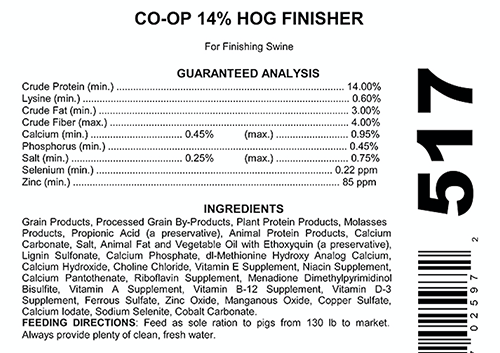Determining Energy Level from Feed Label
Feb 28, 2022

Often, when we hear the merits of two or more beef feeds discussed, the level of protein is mentioned. Not surprising, since the protein percentage is often in the name of the feed and is always listed at the top of the guaranteed nutrients. Protein definitely is important as a component of muscle tissue, organs, hide, and hair, but as a rule, the animal industry tends to overemphasize protein while paying little attention to energy content.
Of all the dietary components required by an animal, energy is needed in the largest quantity. Growth, reproduction, and lactation are all driven by the amount of energy consumed. So, given its importance, why is energy content not listed on the feed label? Each state in the U.S. writes its own laws regarding feed label rules and regulations. Their own regulatory personnel is then responsible for inspecting feed labels, analyzing feed samples, and enforcing those standards. At present, accurately testing for energy content is both complicated and expensive, and thus a guarantee is not required on a feed label.
Fat content is listed on the feed label, and is a concentrated source of energy, but does not tell all there is to know about energy content. Fiber fractions and their digestibility have a larger bearing on the energy value of a feedstuff. It is easily possible to have a feed with an appreciable amount of fat listed on its label that would be low in total energy.
The total ingredient makeup must be considered. Look for feeds with high levels of soluble (digestible) fiber, which is easily converted to energy by cattle, and is abundant in ingredients such as wheat middlings, soybean hulls, corn gluten feed, and citrus pulp. Non-structural carbohydrates such as sugars and starches are also energetic and will be present in corn or other grains.
While it is unfortunate that energy content isn’t more easily determined from a feed tag, paying attention to ingredient composition and content of nutrients other than fat is the best way to estimate energy value without chemical analysis.
For more content like this, check out the latest issue of the Cooperator.
Of all the dietary components required by an animal, energy is needed in the largest quantity. Growth, reproduction, and lactation are all driven by the amount of energy consumed. So, given its importance, why is energy content not listed on the feed label? Each state in the U.S. writes its own laws regarding feed label rules and regulations. Their own regulatory personnel is then responsible for inspecting feed labels, analyzing feed samples, and enforcing those standards. At present, accurately testing for energy content is both complicated and expensive, and thus a guarantee is not required on a feed label.
Fat content is listed on the feed label, and is a concentrated source of energy, but does not tell all there is to know about energy content. Fiber fractions and their digestibility have a larger bearing on the energy value of a feedstuff. It is easily possible to have a feed with an appreciable amount of fat listed on its label that would be low in total energy.
The total ingredient makeup must be considered. Look for feeds with high levels of soluble (digestible) fiber, which is easily converted to energy by cattle, and is abundant in ingredients such as wheat middlings, soybean hulls, corn gluten feed, and citrus pulp. Non-structural carbohydrates such as sugars and starches are also energetic and will be present in corn or other grains.
While it is unfortunate that energy content isn’t more easily determined from a feed tag, paying attention to ingredient composition and content of nutrients other than fat is the best way to estimate energy value without chemical analysis.
For more content like this, check out the latest issue of the Cooperator.